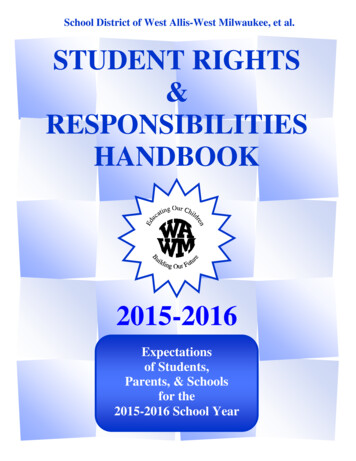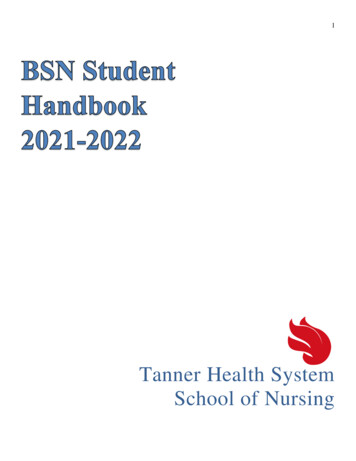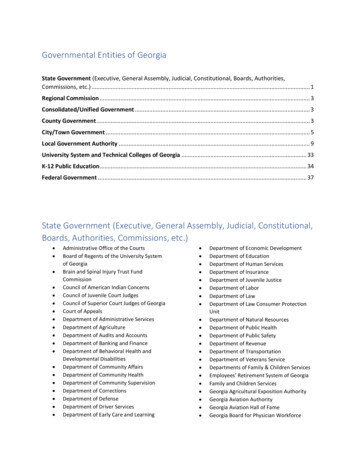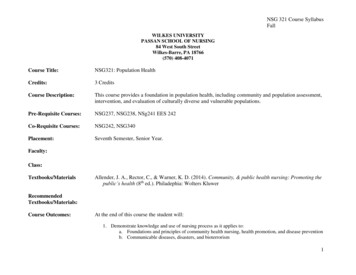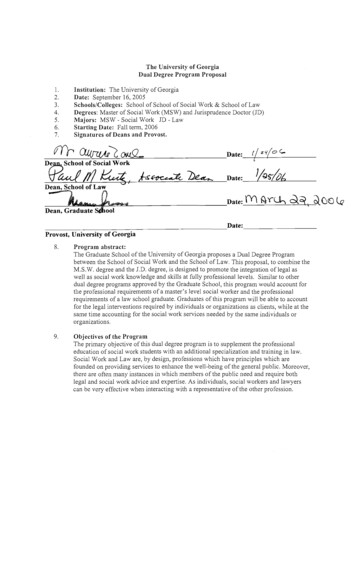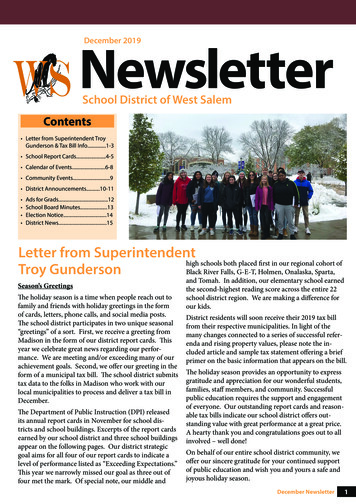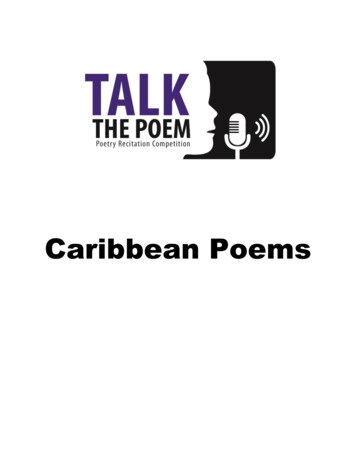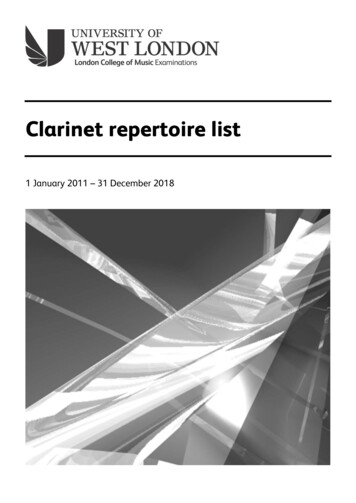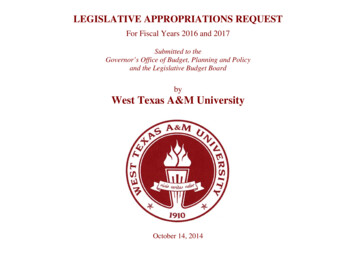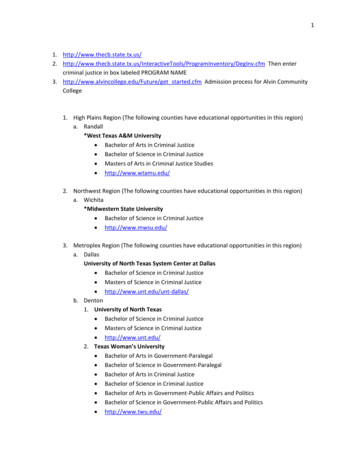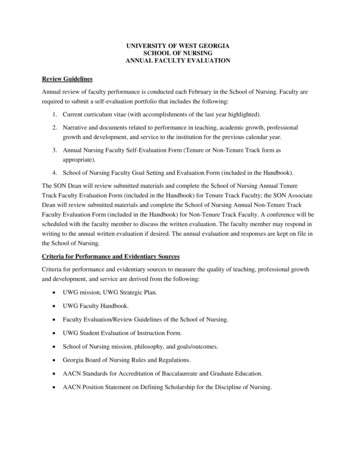
Transcription
UNIVERSITY OF WEST GEORGIASCHOOL OF NURSINGANNUAL FACULTY EVALUATIONReview GuidelinesAnnual review of faculty performance is conducted each February in the School of Nursing. Faculty arerequired to submit a self-evaluation portfolio that includes the following:1. Current curriculum vitae (with accomplishments of the last year highlighted).2. Narrative and documents related to performance in teaching, academic growth, professionalgrowth and development, and service to the institution for the previous calendar year.3. Annual Nursing Faculty Self-Evaluation Form (Tenure or Non-Tenure Track form asappropriate).4. School of Nursing Faculty Goal Setting and Evaluation Form (included in the Handbook).The SON Dean will review submitted materials and complete the School of Nursing Annual TenureTrack Faculty Evaluation Form (included in the Handbook) for Tenure Track Faculty; the SON AssociateDean will review submitted materials and complete the School of Nursing Annual Non-Tenure TrackFaculty Evaluation Form (included in the Handbook) for Non-Tenure Track Faculty. A conference will bescheduled with the faculty member to discuss the written evaluation. The faculty member may respond inwriting to the annual written evaluation if desired. The annual evaluation and responses are kept on file inthe School of Nursing.Criteria for Performance and Evidentiary SourcesCriteria for performance and evidentiary sources to measure the quality of teaching, professional growthand development, and service are derived from the following: UWG mission, UWG Strategic Plan. UWG Faculty Handbook. Faculty Evaluation/Review Guidelines of the School of Nursing. UWG Student Evaluation of Instruction Form. School of Nursing mission, philosophy, and goals/outcomes. Georgia Board of Nursing Rules and Regulations. AACN Standards for Accreditation of Baccalaureate and Graduate Education. AACN Position Statement on Defining Scholarship for the Discipline of Nursing.
BOYER’S MODEL OF FACULTY EVALUATIONIn 1999, the American Association of Colleges of Nursing (AACN) approved a position statement thatdefines scholarship for the discipline of nursing, identifies standards, and provides examples ofdocumentation for the quality of scholarship in each of Boyer’s four areas. The faculty of the Universityof West Georgia School of Nursing adopted the AACN Position Statement. The following examples serveas a guide for the evaluation of professional growth and development in the School of Nursing.The Scholarship of DiscoveryCharacterized by primary empirical research, historical research, theory development and testing,methodological studies, and philosophical inquiry and analysis.Evidentiary sources for measuring the quality of discovery scholarship include: Peer-reviewed publications of research, theory, or philosophy. Peer-reviewed and invited presentations of research, theory, or philosophical essays. Published books, monographs, and/or book chapters. Grant awards supporting research/scholarship. Unfunded grant proposals that have received peer review and/or approval. Effective mentorship of colleagues in research/scholarship. State, regional, national, or international recognition as a scholar in an identified area. Peer evaluations of the body of work. Ongoing scholarly projects related to discovery.The Scholarship of TeachingConducted through the application of knowledge of the discipline or specialty area in the teachinglearning process, the development of innovative teaching and evaluation methods, program development,learning outcome evaluation, and professional role modeling.Evidentiary sources for measuring the quality of the teaching scholarship include: Peer-reviewed publications of research related to teaching methodology or learning outcomes,case studies related to teaching-learning, learning theory development, and development ortesting of educational models or theories. Peer-reviewed or invited presentations related to teaching. Published books, monographs, book chapters, and/or other learning aids. Funded grant awards in support of teaching and learning. Unfunded grant proposals that have received peer review and/or approval.
Effective mentorship of students and novice faculty in teaching. Accreditation or other comprehensive program reports. Successful applications of information technology to teaching and learning. State, regional, national, or international recognition as a master teacher. Design of outcome studies or evaluation/assessment programs. Successful course, curriculum, and/or program development. Creation of caring and innovative learning environments. Peer assessments of effective innovations in teaching. Ongoing scholarly projects related to teaching.The Scholarship of Practice (Application)Includes the roles of direct caregiver, educator, consultant, and administrator and is conducted through theapplication of nursing and related knowledge to the assessment and validation of patient care outcomes,the measurement of quality of life indicators, the development and refinement of practiceprotocols/strategies, the evaluation of systems of care and the analysis of innovative healthcare deliverymodels.Evidentiary sources for measuring the quality of the scholarship of practice (application) include: Peer-reviewed publications of research, case studies, technical applications, or other practiceissues. Peer-reviewed or invited presentations related to practice. Published books, monographs, and/or book chapters. Funded grant awards in support of practice. Unfunded grant proposals that have received peer review and/or approval. Effective mentorship of professional nurses in clinical practice. Consultation reports. Reports compiling or analyzing patient or health services outcomes. Copyrights, licenses, patents, or products for sale. State, regional, national, or international recognition as a master practitioner. Professional certifications, degrees, and other specialty credentials. Reports of meta-analyses related to practice problems.
Reports of clinical demonstration projects. Policy papers related to practice. Peer reviews of effective practice. Ongoing scholarly projects related to clinical practice.The Scholarship of IntegrationRequires participation from two or more disciplines that advances knowledge across a wide range oftechniques and methodologies.Evidentiary sources for measuring the quality of integration scholarship include: Peer-reviewed publications/presentations of research, policy analysis, case studies, integrativereviews of literature. Peer-reviewed or invited presentations related to integration scholarship. Published books, monographs, and/or book chapters. Funded interdisciplinary grant awards. Unfunded grant proposals that have received peer review and/or approval. Effective mentorship of colleagues in the scholarship of integration. Copyrights, licenses, patents, or products for sale. Reports of interdisciplinary programs or service projects. Policy papers designed to influence organizations or governments. Peer evaluations of contributions to integrative scholarship. Ongoing scholarly projects related to integration.In addition to the above, the University of West Georgia recognizes the following as evidentiary sourcesfor measuring quality in professional growth and development: Membership on editorial/review boards. Consultation that involves the application of professional expertise. Election or appointment to offices in professional organizations. Successful committee work that involves important service to state, regional, national, orinternational professional associations.Evaluation of Professional Growth and DevelopmentBoyer (1990) describes an alternate paradigm for the consideration of scholarship in academia. Within
this paradigm, legitimacy is ascribed to the full scope of academic work. He defines four areas ofscholarship: discovery, integration, application, and teaching. The scholarship of discovery represents thetraditional view of academic research and seeks to answer the question, “What is to be known, what is yetto be found?” (p. 19). It involves investigative research efforts to produce new knowledge. Thescholarship of integration focuses on the interpretation and synthesis of existing knowledge to bring aboutnew insights and ideas. It uses research data to better understand the nature of one’s own discipline,makes connections with other disciplines, and asks, “What do the findings mean?” (p. 19). Thescholarship of application focuses on the interaction of theory and practice and is concerned withapplying the knowledge of one’s academic discipline to “real world” settings to solve problems or toprovide needed service to individuals, groups, or institutions. It asks, “How can knowledge be responsiblyapplied to consequential problems? How can it be helpful to individuals as well as institutions?” (p. 21).Lastly, the scholarship of teaching involves transforming and extending knowledge through teachinglearning strategies that stimulate active learning and encourage students to be critical and creativethinkers.Boyer’s (1990) world view expands the traditional views of scholarship, teaching, and service and createsa context of freedom for faculty to pursue scholarship in a much broader sense. The School of Nursingbelieves that Boyer’s model honors the diversity of talents and interests that represents us as facultymembers of the University of West Georgia and as members of the practice discipline of nursing.References:Boyer, E. L. (1990). Scholarship reconsidered: Priorities of the professoriate. Princeton, NJ: TheCarnegie Foundation for the Advancement of Teaching.American Association of Schools of Nursing. (1999). Position statement on defining scholarship for thediscipline of nursing. Washington, DC: Author.Evaluation of TeachingEffective teaching is central to the mission of the University and the School of Nursing in our quest for“educational excellence in a personal environment.” The maintenance of high quality undergraduate andgraduate education depends upon teaching excellence. The faculty in the School of Nursing at theUniversity of West Georgia believe that evidence-based teaching is essential to a quality nursing programand that teaching is a scholarly activity (Boyer, 1990).Evidentiary sources for measuring the quality of teaching include: Student evaluations of teaching effectiveness. Peer evaluations of teaching effectiveness. Dean evaluations of teaching effectiveness. Well-developed Teaching Portfolio. Student attainment of School of Nursing goals and program objectives.
Honors or special recognitions for teaching accomplishments. Letters from former students attesting to the faculty member’s instructional abilities. Effective direction of independent student work and research such as scholarly projects andtheses.PEER TEACHING OBSERVATION AS EVIDENCE-BASED TEACHING(APPROVED 2/28/05)Peer teaching observation supports educational excellence in a caring environment and demonstrates thecommitment of the School of Nursing to nurture and develop its faculty as teacher scholars. It has valuein improving instruction and making personnel decisions and utilizes observers who have knowledge ofpedagogy and the processes of evaluation and receive workload consideration for their efforts.Peer teaching observation is required for:1. First-year tenure-track and non-tenure track clinical faculty2. Non tenure track faculty in their third and fifth years and every five years thereafter.3. Mentors will serve as peer observers for all first year faculty. The peer observer for subsequentfaculty observations will be selected by the faculty member in consultation with the SON Dean.Peer teaching observation is optional for tenure track faculty after the first year. Its use in third-yearreview, promotion and tenure, and post-tenure review is strongly suggested. The peer observer will beselected by the faculty member in consultation with the SON Dean and/or Associate Dean.Peer teaching observation includes classroom, campus lab, and clinical observations (as relevant) andconsists of pre-observation, observation, and post-observation sessions between teacher and observer, thetime/place for which are mutually determined. A rating scale and narrative component will be used toassess the following:1. Classroom/campus lab – caring teacher-learner interaction; demonstrated knowledge in subjectarea; course management; content organization; presentation style; instructionalmaterials/strategies/technology; enthusiasm for teaching; evaluation of learning.2. Clinical – caring teacher-learner interaction; demonstrated clinical knowledge/proficiency;maintenance of patient/learner safety; course management; selection/organization of learningexperiences; instructional materials/strategies/technology; enthusiasm for teaching; evaluation oflearning.Peer Review Evaluation Forms – Clinical Instruction and Classroom Instruction are located in section IVand on the nursing “j” drive.
Evaluation of ServiceAll University and School of Nursing faculty are also expected to provide service to the institution andthe broader community. In this area, faculty members have the opportunity to support not only theadvancement of the institution’s mission and goals but also to enrich the local community.Evidentiary sources for measuring quality in community service include: Active participation in School of Nursing, university, and university-wide committees. Effective leadership of School of Nursing and university groups. Successful development of service programs or projects. Effective service-related consultation work or technical assistance. Successful counseling/advising of students and student groups. Successful service as a Caring Group facilitator. Successful service on local, statewide, regional, national, or international levels in communityservice organizations. Honors, awards, and special recognitions for service to the institution or the community. Significant contributions to the improvement of student, faculty or community life. Effective mentoring of colleagues.GUIDELINES FOR FACULTY APPOINTMENT, PROMOTION, AND TENUREThis document addresses the criteria for appointment and promotion in the Tenure Track and Non-TenureTrack faculty ranks. The criteria are derived from the School of Nursing statement on the Evaluation ofTenure Track Nursing Faculty and Non-Tenure Track Nursing Faculty in the SON Faculty Handbook andthe University of West Georgia Faculty Handbook sections on Minimum Criteria for Appointment(101.02) and Promotion (103.0302). Appropriate evidentiary sources for teaching, service, andprofessional growth and development are identified in the Evaluation of Nursing Faculty document andthe UWG Faculty Handbook, Section 103.0302,D.
UNIVERSITY OF WEST GEORGIASCHOOL OF NURSINGFACULTY GOAL SETTING AND EVALUATION FORMName Rank DateList goals in each of the three areas. For each goal, identify additional information as appropriate (i.e.,plans for meeting the goal, the time frame, needed resources or support, means of assessment, etc.).TEACHING GOALS (%):PROFESSIONAL GROWTH AND DEVELOPMENT GOALS (SERVICE GOALS (%):%):Goals Setting Conference DateCOMMENTS:Signature of Faculty MemberSignature of Department ChairReview of Goals Conference DateCOMMENTS:Signature of Faculty MemberSignature of Department ChairEvaluation Conference DateCOMMENTS:Signature of Faculty MemberSignature of Department Chair
UNIVERSITY OF WEST GEORGIASCHOOL OF NURSINGANNUAL TENURE TRACK NURSING FACULTYDEAN EVALUATION FORMFACULTY MEMBER:RANK/TENURE STATUS:EARNED ACADEMIC DEGREES:EVALUATION YEAR:RANKINGS: 5 Strongly Agree; 4 Agree; 3 Uncertain; 2 Disagree; 1 Strongly Disagree; NA NotAppropriateRANKINGS5 4 3 2 1 NATEACHING (%)EVIDENCE/COMMENTS1. Teaches in a manner that reflects thedepartment philosophy and program mission andlearning objectives.2. Implements the curriculum using approvedcourse learning goals/content and appropriateteaching-learning strategies.3. Incorporates current nursing knowledge/theory/research and professionalstandards/guidelines for practice.4. Creates a personal learning environment that ischaracterized by caring and holism.5. Works collaboratively with learners to developcritical thinking skills.6. Demonstrates innovations in professionaleducation7. Employs information technology successfully.8. Supervises independent student work/researchprojects effectively.9. Adheres to university and department policiesrelated to teaching.10. Earns positive student evaluations of teachingeffectiveness.11. Earns positive peer evaluations of teachingeffectiveness.12. Evaluates own teaching effectivenessaccurately.13. Utilizes student, peer, and chair evaluations toimprove teaching effectiveness.14. Provides evidence of maintaining a TeachingPortfolio.Number of new courses developedNumber of honor’s sections taught
PROFESSIONAL GROWTH ANDDEVELOPMENT ( %)5RANKINGS4 3 2 1NAEVIDENCE/COMMENTSAREA OF FOCUS:1. Submits manuscripts to peer-reviewedpublications.2. Publishes in peer-reviewed publications.3. Submits abstracts for regional, national orinternational presentation.4. Presents papers at regional, national orinternational conferences.5. Publishes books, monographs, or bookchapters.6. Serves on editorial/review boards.7. Participates in notable continuing educationefforts.8. Maintains professional certifications.9. Maintains professional nursing practice.10. Achieves professional recognition.11. Submits grant proposals.12. Receives grant funding.13. Serves as professional nursing consultant andexpert.14. Actively participates in professionalorganizations.15. Assumes leadership roles in professionalorganizations.16. Demonstrates the scholarship of discovery,teaching, integration, or application through thefollowing additional activities:Number of books and monographsNumber of book chaptersNumber of peer-reviewed articles submittedNumber of peer-reviewed articles acceptedNumber of paper presentations submittedNumber of paper presentations acceptedNumber of positions held in journal editing/reviewNumber of grant proposals submittedNumber of grant proposals fundedNumber memberships in honors organizationsNumber offices held in professional organizations
54RANKINGS3 2 1NASERVICE ( %)1.Works cooperatively and collaboratively withothers to meet department goals.2. Meets departmental committee obligationseffectively.3. Performs effectively in leadership roles in thedepartment.4. Seeks service on Department, university, orsystem-wide committees.5. Meets Department, university, or system-widecommittee obligations effectively.6. Performs effectively in leadership roles in theDepartment, university, or system.7. Meets advising responsibilities effectively.EVIDENCE/COMMENTS8. Successfully serves as faculty advisor tostudent groups.9. Successfully serves as a course coordinator.10. Successfully serves as a Caring Groupfacilitator.11. Successfully serves as mentor to new faculty.12. Actively participates in community serviceorganizations (e.g., committees, boards, panels).13. Performs effectively in leadership roles in thecommunity.Number of Department/university/system-wide committee appointmentsWorkload hours: Spring semesterFall semesterNotable continuing education or academic advancement during the evaluation period:Strengths/Areas for Growth/Comments:I have read this evaluation and discussed it with the Chair of the Department.Faculty signature/DateChair signature/DateForm Reviewed April 23, 2007
UNIVERSITY OF WEST GEORGIASCHOOL OF NURSINGANNUAL TENURE TRACK NURSING FACULTYSELF-EVALUATION FORMFACULTY MEMBER:RANK/TENURE STATUS:EARNED ACADEMIC DEGREES:EVALUATION YEAR:RANKINGS: 5 Strongly Agree; 4 Agree; 3 Uncertain; 2 Disagree; 1 Strongly Disagree; NA NotAppropriateRANKINGS5 4 3 2 1 N EVIDENCE/COMMENTSATEACHING (
the School of Nursing. Criteria for Performance and Evidentiary Sources Criteria for performance and evidentiary sources to measure the quality of teaching, professional growth and development, and service are derived from the following: UWG mission, UWG Strategic Plan. UWG Faculty Handbook.
